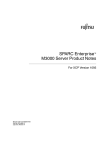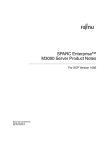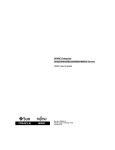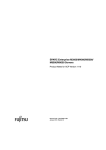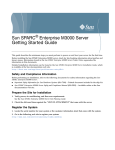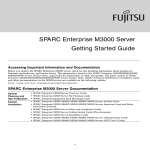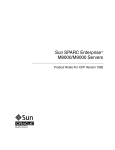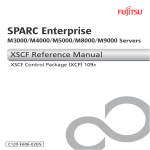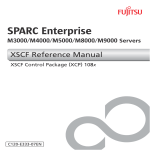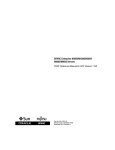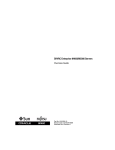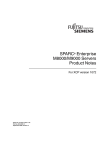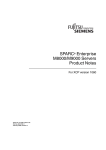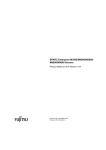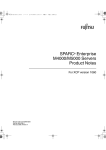Download SPARC Enterprise M3000 Server Product Notes For XCP
Transcript
SPARC Enterprise™ M3000 Server Product Notes For XCP Version 1092 Manual Code C120-E621-01EN Part No. 875-4648-10 April 2010, Revision A Copyright 2010 Sun Microsystems, Inc., 4150 Network Circle, Santa Clara, California 95054, U.S.A. and FUJITSU LIMITED, 1-1, Kamikodanaka 4-chome, Nakahara-ku, Kawasaki-shi, Kanagawa-ken 211-8588, Japan. All rights reserved. Sun Microsystems, Inc. and Fujitsu Limited each own or control intellectual property rights relating to products and technology described in this document, and such products, technology and this document are protected by copyright laws, patents and other intellectual property laws and international treaties. The intellectual property rights of Sun Microsystems, Inc. and Fujitsu Limited in such products, technology and this document include, without limitation, one or more of the United States patents listed at http://www.sun.com/patents and one or more additional patents or patent applications in the United States or other countries. This document and the product and technology to which it pertains are distributed under licenses restricting their use, copying, distribution, and decompilation. No part of such product or technology, or of this document, may be reproduced in any form by any means without prior written authorization of Fujitsu Limited and Sun Microsystems, Inc., and their applicable licensors, if any. The furnishing of this document to you does not give you any rights or licenses, express or implied, with respect to the product or technology to which it pertains, and this document does not contain or represent any commitment of any kind on the part of Fujitsu Limited or Sun Microsystems, Inc., or any affiliate of either of them. This document and the product and technology described in this document may incorporate third-party intellectual property copyrighted by and/or licensed from suppliers to Fujitsu Limited and/or Sun Microsystems, Inc., including software and font technology. Per the terms of the GPL or LGPL, a copy of the source code governed by the GPL or LGPL, as applicable, is available upon request by the End User. Please contact Fujitsu Limited or Sun Microsystems, Inc. This distribution may include materials developed by third parties. Parts of the product may be derived from Berkeley BSD systems, licensed from the University of California. UNIX is a registered trademark in the U.S. and in other countries, exclusively licensed through X/Open Company, Ltd. Sun, Sun Microsystems, the Sun logo, Java, Netra, Solaris, Sun Ray, Answerbook2, docs.sun.com, OpenBoot, and Sun Fire are trademarks or registered trademarks of Sun Microsystems, Inc., or its subsidiaries, in the U.S. and other countries. Fujitsu and the Fujitsu logo are registered trademarks of Fujitsu Limited. All SPARC trademarks are used under license and are registered trademarks of SPARC International, Inc. in the U.S. and other countries. Products bearing SPARC trademarks are based upon architecture developed by Sun Microsystems, Inc. SPARC64 is a trademark of SPARC International, Inc., used under license by Fujitsu Microelectronics, Inc. and Fujitsu Limited. The OPEN LOOK and Sun™ Graphical User Interface was developed by Sun Microsystems, Inc. for its users and licensees. Sun acknowledges the pioneering efforts of Xerox in researching and developing the concept of visual or graphical user interfaces for the computer industry. Sun holds a non-exclusive license from Xerox to the Xerox Graphical User Interface, which license also covers Sun’s licensees who implement OPEN LOOK GUIs and otherwise comply with Sun’s written license agreements. United States Government Rights - Commercial use. U.S. Government users are subject to the standard government user license agreements of Sun Microsystems, Inc. and Fujitsu Limited and the applicable provisions of the FAR and its supplements. Disclaimer: The only warranties granted by Fujitsu Limited, Sun Microsystems, Inc. or any affiliate of either of them in connection with this document or any product or technology described herein are those expressly set forth in the license agreement pursuant to which the product or technology is provided. EXCEPT AS EXPRESSLY SET FORTH IN SUCH AGREEMENT, FUJITSU LIMITED, SUN MICROSYSTEMS, INC. AND THEIR AFFILIATES MAKE NO REPRESENTATIONS OR WARRANTIES OF ANY KIND (EXPRESS OR IMPLIED) REGARDING SUCH PRODUCT OR TECHNOLOGY OR THIS DOCUMENT, WHICH ARE ALL PROVIDED AS IS, AND ALL EXPRESS OR IMPLIED CONDITIONS, REPRESENTATIONS AND WARRANTIES, INCLUDING WITHOUT LIMITATION ANY IMPLIED WARRANTY OF MERCHANTABILITY, FITNESS FOR A PARTICULAR PURPOSE OR NON-INFRINGEMENT, ARE DISCLAIMED, EXCEPT TO THE EXTENT THAT SUCH DISCLAIMERS ARE HELD TO BE LEGALLY INVALID. Unless otherwise expressly set forth in such agreement, to the extent allowed by applicable law, in no event shall Fujitsu Limited, Sun Microsystems, Inc. or any of their affiliates have any liability to any third party under any legal theory for any loss of revenues or profits, loss of use or data, or business interruptions, or for any indirect, special, incidental or consequential damages, even if advised of the possibility of such damages. DOCUMENTATION IS PROVIDED “AS IS” AND ALL EXPRESS OR IMPLIED CONDITIONS, REPRESENTATIONS AND WARRANTIES, INCLUDING ANY IMPLIED WARRANTY OF MERCHANTABILITY, FITNESS FOR A PARTICULAR PURPOSE OR NONINFRINGEMENT, ARE DISCLAIMED, EXCEPT TO THE EXTENT THAT SUCH DISCLAIMERS ARE HELD TO BE LEGALLY INVALID. Please Recycle Copyright 2010 Sun Microsystems, Inc., 4150 Network Circle, Santa Clara, California 95054, U.S.A. et FUJITSU LIMITED, 1-1, Kamikodanaka 4-chome, Nakahara-ku, Kawasaki-shi, Kanagawa-ken 211-8588, Japon. Tous droits réservés. Entrée et revue tecnical fournies par Fujitsu Limited sur des parties de ce matériel. Sun Microsystems, Inc. et Fujitsu Limited détiennent et contrôlent toutes deux des droits de propriété intellectuelle relatifs aux produits et technologies décrits dans ce document. De même, ces produits, technologies et ce document sont protégés par des lois sur le copyright, des brevets, d’autres lois sur la propriété intellectuelle et des traités internationaux. Les droits de propriété intellectuelle de Sun Microsystems, Inc. et Fujitsu Limited concernant ces produits, ces technologies et ce document comprennent, sans que cette liste soit exhaustive, un ou plusieurs des brevets déposés aux États-Unis et indiqués à l’adresse http://www.sun.com/patents de même qu’un ou plusieurs brevets ou applications brevetées supplémentaires aux États-Unis et dans d’autres pays. Ce document, le produit et les technologies afférents sont exclusivement distribués avec des licences qui en restreignent l’utilisation, la copie, la distribution et la décompilation. Aucune partie de ce produit, de ces technologies ou de ce document ne peut être reproduite sous quelque forme que ce soit, par quelque moyen que ce soit, sans l’autorisation écrite préalable de Fujitsu Limited et de Sun Microsystems, Inc., et de leurs éventuels bailleurs de licence. Ce document, bien qu’il vous ait été fourni, ne vous confère aucun droit et aucune licence, expresses ou tacites, concernant le produit ou la technologie auxquels il se rapporte. Par ailleurs, il ne contient ni ne représente aucun engagement, de quelque type que ce soit, de la part de Fujitsu Limited ou de Sun Microsystems, Inc., ou des sociétés affiliées. Ce document, et le produit et les technologies qu’il décrit, peuvent inclure des droits de propriété intellectuelle de parties tierces protégés par copyright et/ou cédés sous licence par des fournisseurs à Fujitsu Limited et/ou Sun Microsystems, Inc., y compris des logiciels et des technologies relatives aux polices de caractères. Par limites du GPL ou du LGPL, une copie du code source régi par le GPL ou LGPL, comme applicable, est sur demande vers la fin utilsateur disponible; veuillez contacter Fujitsu Limted ou Sun Microsystems, Inc. Cette distribution peut comprendre des composants développés par des tierces parties. Des parties de ce produit pourront être dérivées des systèmes Berkeley BSD licenciés par l’Université de Californie. UNIX est une marque déposée aux Etats-Unis et dans d’autres pays et licenciée exclusivement par X/Open Company, Ltd. Sun, Sun Microsystems, le logo Sun, Java, Netra, Solaris, Sun Ray, Answerbook2, docs.sun.com, OpenBoot, et Sun Fire sont des marques de fabrique ou des marques déposées de Sun Microsystems, Inc., ou ses filiales, aux Etats-Unis et dans d’autres pays. Fujitsu et le logo Fujitsu sont des marques déposées de Fujitsu Limited. Toutes les marques SPARC sont utilisées sous licence et sont des marques de fabrique ou des marques déposées de SPARC International, Inc. aux Etats-Unis et dans d’autres pays. Les produits portant les marques SPARC sont basés sur une architecture développée par Sun Microsystems, Inc. SPARC64 est une marques déposée de SPARC International, Inc., utilisée sous le permis par Fujitsu Microelectronics, Inc. et Fujitsu Limited. L’interface d’utilisation graphique OPEN LOOK et Sun™ a été développée par Sun Microsystems, Inc. pour ses utilisateurs et licenciés. Sun reconnaît les efforts de pionniers de Xerox pour la recherche et le développement du concept des interfaces d’utilisation visuelle ou graphique pour l’industrie de l’informatique. Sun détient une license non exclusive de Xerox sur l’interface d’utilisation graphique Xerox, cette licence couvrant également les licenciés de Sun qui mettent en place l’interface d’utilisation graphique OPEN LOOK et qui, en outre, se conforment aux licences écrites de Sun. Droits du gouvernement américain - logiciel commercial. Les utilisateurs du gouvernement américain sont soumis aux contrats de licence standard de Sun Microsystems, Inc. et de Fujitsu Limited ainsi qu’aux clauses applicables stipulées dans le FAR et ses suppléments. Avis de non-responsabilité: les seules garanties octroyées par Fujitsu Limited, Sun Microsystems, Inc. ou toute société affiliée de l’une ou l’autre entité en rapport avec ce document ou tout produit ou toute technologie décrit(e) dans les présentes correspondent aux garanties expressément stipulées dans le contrat de licence régissant le produit ou la technologie fourni(e). SAUF MENTION CONTRAIRE EXPRESSÉMENT STIPULÉE DANS CE CONTRAT, FUJITSU LIMITED, SUN MICROSYSTEMS, INC. ET LES SOCIÉTÉS AFFILIÉES REJETTENT TOUTE REPRÉSENTATION OU TOUTE GARANTIE, QUELLE QU’EN SOIT LA NATURE (EXPRESSE OU IMPLICITE) CONCERNANT CE PRODUIT, CETTE TECHNOLOGIE OU CE DOCUMENT, LESQUELS SONT FOURNIS EN L’ÉTAT. EN OUTRE, TOUTES LES CONDITIONS, REPRÉSENTATIONS ET GARANTIES EXPRESSES OU TACITES, Y COMPRIS NOTAMMENT TOUTE GARANTIE IMPLICITE RELATIVE À LA QUALITÉ MARCHANDE, À L’APTITUDE À UNE UTILISATION PARTICULIÈRE OU À L’ABSENCE DE CONTREFAÇON, SONT EXCLUES, DANS LA MESURE AUTORISÉE PAR LA LOI APPLICABLE. Sauf mention contraire expressément stipulée dans ce contrat, dans la mesure autorisée par la loi applicable, en aucun cas Fujitsu Limited, Sun Microsystems, Inc. ou l’une de leurs filiales ne sauraient être tenues responsables envers une quelconque partie tierce, sous quelque théorie juridique que ce soit, de tout manque à gagner ou de perte de profit, de problèmes d’utilisation ou de perte de données, ou d’interruptions d’activités, ou de tout dommage indirect, spécial, secondaire ou consécutif, même si ces entités ont été préalablement informées d’une telle éventualité. LA DOCUMENTATION EST FOURNIE “EN L’ETAT” ET TOUTES AUTRES CONDITIONS, DECLARATIONS ET GARANTIES EXPRESSES OU TACITES SONT FORMELLEMENT EXCLUES, DANS LA MESURE AUTORISEE PAR LA LOI APPLICABLE, Y COMPRIS NOTAMMENT TOUTE GARANTIE IMPLICITE RELATIVE A LA QUALITE MARCHANDE, A L’APTITUDE A UNE UTILISATION PARTICULIERE OU A L’ABSENCE DE CONTREFACON. Contents Preface vii Technical Support Software Resources vii viii Accessing Documentation viii Fujitsu Welcomes Your Comments ix General Information About XCP 1092 What’s New in XCP 1092 1 1 Supported Firmware and Software Solaris OS Patch Information Patches for Solaris 10 5/08 2 3 3 Patches for Emulex PCI Express (PCIe) Cards Updating to XCP 1092 4 4 Resetting the XSCF Firmware 4 Functionality Issues and Limitations Notes on Active Directory Notes on LDAP/SSL 4 4 5 Notes on Power Consumption Monitoring Function and Airflow Indicator Notes on NTP Server 5 5 Notes on the NTP Server Referring to the Local Clock 5 v Notes on XSCF Web 7 General Functionality Issues and Limitations Information About Hardware 8 9 Notes on the Use of 200V Power Supply Notes on DVD Drive and Discs 9 9 Notes on the Use of USB Memory 10 Power Control and Operator Panel Mode Switch Hardware Documentation Updates Information About Software 10 11 12 Active Directory and LDAP/SSL 12 Configuring XSCF for Active Directory Support Notes on User Account Name and UID New proxyuser System Account XCP Issues and Workarounds 14 14 14 15 Known Issues and Workarounds in XCP 1092 XCP Issues Fixed in XCP 1092 15 17 XCP Issues Fixed in Releases Earlier Than XCP 1092 Solaris OS Issues and Workarounds 19 23 Solaris OS Issues and Workarounds for All Supported Releases Solaris OS Issues Fixed in Solaris 10 10/09 Solaris OS Issues Fixed in Solaris 10 5/09 Solaris Issues Fixed in Solaris 10 10/08 Software Documentation Updates 26 27 28 Identifying Degraded Memory in a System vi 26 33 SPARC Enterprise M3000 Server Product Notes for XCP Version 1092 • April 2010 23 Preface These product notes contain late-breaking information about the SPARC Enterprise™ M3000 server hardware, software, or documentation that became known after the documentation set was published. Note – Once an XCP version newer than the XCP version supported by this manual is released, only the manuals related to the new XCP version are subsequently updated. You must therefore check the manuals for the latest XCP version in addition to those related to the XCP version you are using. Global Site http://www.fujitsu.com/sparcenterprise/manual/ Japanese Site http://primeserver.fujitsu.com/sparcenterprise/manual/ North American Site https://download.computers.us.fujitsu.com/ Technical Support If you have technical questions or issues that are not addressed in the SPARC Enterprise M3000 server documentation, contact a sales representative or a certified service engineer. vii Software Resources The Solaris™ Operating System and Sun Java™ Enterprise System software are preinstalled on your SPARC Enterprise M3000 server. Contact a sales representative or a certified service engineer for software resources for your SPARC Enterprise M3000 server. Note – For latest patch information go to: Global Site http://www.fujitsu.com/global/support/software/security/products -s/patch-info/ Japanese Site https://software.fujitsu.com/jp/security/products-others/unix/ North American Site https://download.computers.us.fujitsu.com/ Installation information and README files are included in the patch download. Accessing Documentation Note – Information in these product notes supersedes the information in the SPARC Enterprise M3000 server documentation set. Instructions for installing, administering, and using your SPARC Enterprise M3000 server is provided in the SPARC Enterprise M3000 server documentation set. The documentation set is available for download from the following website: Global Site http://www.fujitsu.com/sparcenterprise/manual/ Japanese Site http://primeserver.fujitsu.com/sparcenterprise/manual/ North American Site https://download.computers.us.fujitsu.com/ viii SPARC Enterprise M3000 Server Product Notes for XCP Version 1092 • April 2010 Sun Microsystems Software (for Solaris OS, etc.) Related Manuals http://docs.sun.com/ Fujitsu Welcomes Your Comments If you have any comments or requests regarding this document, or if you find any unclear statements in the document, please state your points specifically on the form at the following URL. For Users in U.S.A., Canada, and Mexico: http://www.computers.us.fujitsu.com/www/support_servers.shtml?su pport/servers For Users in Other Countries: SPARC Enterprise contact http://www.fujitsu.com/global/contact/computing/sparce_index.html Preface ix x SPARC Enterprise M3000 Server Product Notes for XCP Version 1092 • April 2010 General Information About XCP 1092 This section describes the general information about XCP 1092. ■ ■ ■ ■ “What’s New in XCP 1092” on page 1 “Supported Firmware and Software” on page 2 “Updating to XCP 1092” on page 4 “Functionality Issues and Limitations” on page 4 What’s New in XCP 1092 In XCP version 1092, the following new feature is introduced: ■ The following new XSCF commands are supported: ■ ■ setpacketfilters(8) showpacketfilters(8) For detail, see the man pages for each command. ■ The following options for specifying a proxy server and a login user name are supported in the loadcert operand of setad(8) and setldapssl(8): ■ ■ ■ -p proxy -t proxy_type -u username For detail, see the man pages for each command. ■ The websites which can download the latest files of XCP firmware are changed as follows: ■ Global Site: old: http://www.fujitsu.com/sparcenterprise/firmware/ new: https://updatesite.jp.fujitsu.com/unix/en/download/firmware/ 1 ■ Japanese Site: old: http://primeserver.fujitsu.com/sparcenterprise/download/firm ware/ new: https://updatesite.jp.fujitsu.com/unix/jp/download/firmware/ ■ The SPARC64™ VII processor of 2.75GHz frequency now can be mounted on the SPARC Enterprise™ M3000 server. Supported Firmware and Software The following firmware and operating system (OS) are supported depending on the processors being installed on the SPARC Enterprise M3000 server.. TABLE 1 Supported Firmware and Operating System Versions Installed Processors XCP Version Operating System Version 2.52GHz XCP 1080 or later Solaris 10 5/08 or later, with required patches 2.75GHz XCP 1091 or later Solaris 10 10/08 or later SPARC64 VII processors Note – XCP 1080 is the first XCP release for the SPARC Enterprise M3000 server. Note – 8GB DIMM is supported in XCP 1081 or later. For XCP, you can download the latest files of firmware at the following websites. Global Site: https://updatesite.jp.fujitsu.com/unix/en/download/firmware/ Japanese Site: https://updatesite.jp.fujitsu.com/unix/jp/download/firmware/ 2 SPARC Enterprise M3000 Server Product Notes for XCP Version 1092 • April 2010 Many web browsers support the XSCF Web. The browsers in TABLE 2 have demonstrated compatibility with the XSCF Web through testing. For other information about XSCF Web, see “Notes on XSCF Web” on page 7. Tested Web Browser Versions TABLE 2 Web Browser Application ® Microsoft Internet Explorer Version ®* Firefox (Solaris 10) 6.0, 7.0, or 8.0 2.0† *. Microsoft and Internet Explorer are either registered trademarks or trademarks of Microsoft Corporation in the United States and/or other countries. †. The Firefox 3 is not supported in XSCF Web. Solaris OS Patch Information Patches are not required for servers running Solaris 10 10/08 OS or later. Patches for Solaris 10 5/08 The following patches are required for Solaris 10 5/08 OS only on servers containing SPARC64 VII 2.52GHz processors: ■ ■ ■ 119254-59 138866-01 137137-09 For additional Solaris Operating System information, see “Solaris OS Issues and Workarounds” on page 23. Note – See “Software Resources” on page viii for information on how to find the latest patches. Installation information and README files are included in the patch download. General Information About XCP 1092 3 Patches for Emulex PCI Express (PCIe) Cards The following Emulex cards require drivers supplied in patch 120222-26: ■ XSEFC402AF Sun StorageTek Enterprise Class 4Gb Dual-Port Fibre Channel PCIE HBA ■ XSEFC401AF Sun StorageTek Enterprise Class 4Gb Single-Port Fibre Channel PCI-E HBA Updating to XCP 1092 To update your XCP to XCP 1092, refer to the SPARC Enterprise M3000/M4000/M5000/M8000/M9000 Servers XSCF User’s Guide for instructions. Resetting the XSCF Firmware After updating the XCP firmware to 1092, do not fail to reset the XSCF by using the rebootxscf(8) command. Functionality Issues and Limitations This section describes the known issues and limitations at the time of this release. Notes on Active Directory 4 ■ While Active Directory is enabled, when you attempt to login to XSCF via the telnet, you might fail to login due to timeout of the query to secondary alternated server or later. ■ If the specified timeout is too brief for the configuration, the login process or retrieval of user privilege settings could fail. In such case, specify larger value for the timeout and then try again. SPARC Enterprise M3000 Server Product Notes for XCP Version 1092 • April 2010 Notes on LDAP/SSL If the specified timeout is too brief for the configuration, the login process or retrieval of user privilege settings could fail. In such case, specify larger value for the timeout and try again. Notes on Power Consumption Monitoring Function and Airflow Indicator ■ The amount of power consumption and exhaust air might not be indicated correctly in the MIB information, in the showenvironment power and the showenvironment air command output, and on the XSCF Web in the following cases; and you should wait for one minute and check the value again. During the server powering on or powering off, or for a while after the poweron or power-off complete ■ During the active replacement of power supply unit, or for a while after the active replacement complete The figures on the power consumption monitoring function and airflow indicator respectively represent the dissipation power and volume of air exhausted from the server. The figures of peripheral devices are not included. ■ ■ Notes on NTP Server ■ We recommend the domain to use the XSCF Unit as NTP server. In this case, pay attention to the following points: ■ ■ XSCF must be connected to an external NTP server When you connect one or more NTP servers in addition to XSCF, connect the same NTP server as XSCF is using For details on NTP server, contact a service engineer. For details on NTP settings, refer to the SPARC Enterprise M3000/M4000/M5000/M8000/M9000 Servers XSCF User’s Guide. Notes on the NTP Server Referring to the Local Clock When the NTP server which XSCF refers to is referring to the server's own system time (local clock), and when the address of "127.127.1.0" is set to that local clock, time synchronization in XSCF might fail. General Information About XCP 1092 5 The address of the XSCF's own local clock is fixed to "127.127.1.0." On the other hand, when the address of the local clock of the NTP server which XSCF refers to is set to "127.127.1.0," the address of the clock source (refid) has the same value as the address of the XSCF's own local clock. An NTP server like this is excluded from the target of XSCF time synchronization. You can execute the showntp -l command to refer to the address of the NTP server's own clock source which is set in XSCF and the address of the XSCF's own local clock. XSCF> showntp -l remote refid st t when poll reach delay offset jitter ============================================================================== 192.168.1.2 LOCAL(0) 3 u 10 1024 377 0.000 0.000 0.000 *127.127.1.0 .LOCL. 5 l 28 64 377 0.000 0.000 0.008 Of the two NTP server outputs, the upper (192.168.1.2) indicates the NTP server which is set by using the setntp(8) command. The refid is LOCAL(0), which means that the local clock which has the address of "127.127.1.0" is set to the clock source of this NTP server. On the other hand, the lower indicates the XSCF's own local clock. The address of the XSCF's own local clock is fixed to "127.127.1.0." Due to this, the NTP server (192.168.1.2) is excluded from the target of XSCF time synchronization; which results in the XSCF synchronizes with its own local clock. With any of the following measures to avoid the trouble, time can be correctly synchronized with the NTP server which is set by using the setntp(8) command. ● Change the clock source that the NTP server being set in XSCF refers to Use the showntp -l command and check the clock source of the NTP server which is set in XSCF. An NTP server which indicates the refid of LOCAL(0) in the output is referring to the local clock which has the address of "127.127.1.0," and you should change it to refer to another clock source. When you change the clock source of an NTP server, make sure in advance that it has no impact on other NTP clients. ● Change the address of the local clock of the NTP server Of the NTP server which XSCF refers to, change the address of the local clock to "127.127.1.1," "127.127.1.2," or "127.127.1.3." Change /etc/inet/ntp.conf of Solaris OS. To enable the change, restart of the NTP daemon is required. When you change the address of the local clock of an NTP server, make sure in advance that it has no impact on other NTP clients. 6 SPARC Enterprise M3000 Server Product Notes for XCP Version 1092 • April 2010 ● Change the stratum value of the NTP server Of the NTP server which XSCF refers to, change the stratum value to "1." An NTP server which has the stratum value of "1" becomes the most significant clock source and has no refid. Therefore, there is no chance that it will have the same address as the XSCF's own local clock. When you change the stratum value of an NTP server, make sure in advance that it has no impact on other NTP clients. ● Change the address of the XSCF's own local clock By using the setntp -m localaddr=value command, change the address of the XSCF's own local clock. In value, specify the least significant byte of the clock address of the local clock 127.127.1.x for value. A numeric from 0 to 3 can be specified. By specifying either from 1 to 3, the address of an NTP server which is referring to the local clock does not correspond to the address of the XSCF internal local clock anymore, and a server which is referring to the local clock can also be set as the NTP server of XSCF. Notes on XSCF Web ■ ■ Under the Windows 7*1 and Internet Explorer 8.0 environment, XSCF Web does not support the use through the built-in Administrator account. On Internet Explorer 8.0, when you move the on-screen horizontal frame up or down to change the frame height and use the [Monitor Msg Show/Hide] button, the screen background color may turn black. In this case, click Refresh on the View menu or press F5 key to refresh the display, to go back to the screen right after the login. When you moved the on-screen horizontal frame up or down to change the frame height, do not use the [Monitor Msg Show/Hide] button. ■ To use XSCF Web on the SPARC Enterprise M3000 server which is installed the XCP 1080, disable the cache function of your browser. If you leave the browser cache function enabled, the old cached data might be displayed. To disable the cache funtion: ■ Internet Explorer 6 and 7 [Tools] -> [Internet Options...] -> [Advanced] tab and check the "Do not save encrypted pages to disk" box. ■ Netscape 7.1 or later [Edit] -> [Preferences] -> [Advanced] -> [Cache] -> [Compare the page in the cache to the page on the network] setting and select the "Every time I view the page" radio button. *1. Windows is either registered trademarks or trademarks of Microsoft Corporation in the United States and/or other countries. General Information About XCP 1092 7 ■ Firefox 2 Type "about:config" in address box, then type "cache" in filter box. Change the "browser.cache.check_doc_frequency" settings value to "1." ■ Using the XSCF Web, when you import XCP or update the firmware, Session ID error may be displayed on the web browser. And in the Autologout setting, when you specify the timeout period as over 30 minutes, Internal Server Error might be displayed when you perform the firmware update. Please close the current browser and open the new browser to reconnect to XSCF Web. ■ When you use the XSCF Web, if a plug-in such as the search tool installed with the browser, remove the plug-in or disable the pop-up blocking. General Functionality Issues and Limitations 8 ■ The log archive feature by the setarchiving(8) and the showarchiving(8) commands, and the Log Archives menu of XSCF Web is not supported. ■ When you use the external power control interface of the external power controller, the following notification signals are not supported: ■ The OS panic or the server hardware error signal (*CPUN/RTNU) ■ The server hardware error signal (power fail, temperature error, and fan error) (*ALARM) ■ You cannot use the following user account names, as they are reserved for system use: root, bin, daemon, adm, operator, nobody, sshd, rpc, rpcuser, ldap, apache, ntp, admin, proxyuser, and default. ■ XSCF-LAN is compliant with auto-negotiation. When you connect XSCF-LAN and the network device which has been fixed to the full-duplex mode, according to the IEEE 802.3 rule, XSCF-LAN communicates in the half-duplex mode. Due to this, network communication speed may slow down or communication error may occur. Do not fail to set the network device which connects with XSCF-LAN to the auto-negotiation mode. ■ At this time the restoredefaults(8) command is not supported. ■ At this time the -e, -l, -P options of the snapshot(8) command are not supported. SPARC Enterprise M3000 Server Product Notes for XCP Version 1092 • April 2010 Information About Hardware This section describes the special instructions and the issues about the SPARC Enterprise M3000 server hardware. ■ ■ ■ ■ ■ “Notes on the Use of 200V Power Supply” on page 9 “Notes on DVD Drive and Discs” on page 9 “Notes on the Use of USB Memory” on page 10 “Power Control and Operator Panel Mode Switch” on page 10 “Hardware Documentation Updates” on page 11 Notes on the Use of 200V Power Supply For the servers that have the B-type plug, confirm that a 15A overcurrent protection device is available outside the server. If not, prepare an external 15A overcurrent protection that can be achieved by means of no-fuse breakers (NFBs) or fuses. The B-type plug refers to plugs other than grounding-type ones with two parallel blades, such as the NEMA L6-30, L6-20, L6-15, and L5-15. Notes on DVD Drive and Discs See the "Notes on DVD Drives and Discs in SPARC Enterprise" on the website below before using the CD/DVD discs in the standard DVD drive mounted in this server. URL: http://primeserver.fujitsu.com/sparcenterprise/manual/ Information About Hardware 9 Notes on the Use of USB Memory To execute the dumpconfig(8), restoreconfig(8) or snapshot(8) command, if you specify USB memory as the destination to store data, prepare the USB memory as a medium in advance. The data stored will include the information about the system. To use USB memory, you need to pay attention to the management of the USB memory in which the data stored, from the data security viewpoint. We do not provide guarantees to every USB memory from any manufacturers that currently on the market against its connectivity to XSCF and proper operation. Depending on the USB memory in use, defects such as the XSCF firmware error or reset may occur. In case such defects occurred, stop the use of USB memory immediately. To connect the USB memory to the USB port for XSCF, connect the USB memory directly to the USB port. If connected via USB hub or USB extension cables, it may cause errors. Power Control and Operator Panel Mode Switch You can use the mode switch on the operator panel to switch between system power-on/off when you use the remote power control utilizing the RCI function or the automatic power control system (APCS). For details, see the "Limitations and Cautions" in "Preface" of the SPARC Enterprise M3000 Server Service Manual. 10 SPARC Enterprise M3000 Server Product Notes for XCP Version 1092 • April 2010 Hardware Documentation Updates This section contains late-breaking hardware information that became known after the documentation set was published and corrections in the SPARC Enterprise M3000 server hardware documentation. TABLE 3 lists known documentation updates. TABLE 3 Hardware Documentation Updates Title Page Number Update SPARC Enterprise M3000 Server Overview Guide 1-25 1.4.6.2 "SAS Port" The article on "SAS Port" will be replaced by the following. The SAS port connects the server to an external device, such as a tape drive, which has an SAS interface. For information on which devices can be connected, contact a service engineer. Note that the transfer rate of this port is up to 600MB/s (3Gbps x 2wide). Information About Hardware 11 Information About Software This section describes the special instructions and the issues about the SPARC Enterprise M3000 server software. ■ ■ ■ ■ ■ “Supported Firmware and Software” on page 2 “XCP Issues and Workarounds” on page 15 “Solaris OS Issues and Workarounds” on page 23 “Software Documentation Updates” on page 28 “Identifying Degraded Memory in a System” on page 33 Active Directory and LDAP/SSL The XCP 1091 release introduces support for the Active Directory®*1 and LDAP/SSL features. ■ ■ Active Directory is a distributed directory service from Microsoft®*1 Corporation. Like an LDAP directory service, it is used to authenticate users. LDAP/SSL offers enhanced security to LDAP users by way of Secure Socket Layer (SSL) technology. It uses LDAP directory service to authenticate users. Note – For security reasons, XSCF uses only LDAP over SSL protocol (LDAPS) to communicate with an Active Directory server or an LDAP/SSL server. Active Directory and LDAP/SSL each provides both authentication of user credentials and authorization of the user access level to networked resources. They use authentication to verify the identity of users before they can access system resources, and to grant specific access privileges to users in order to control their rights to access networked resources. *1. Microsoft and Active Directory are either registered trademarks or trademarks of Microsoft Corporation in the United States and/or other countries. 12 SPARC Enterprise M3000 Server Product Notes for XCP Version 1092 • April 2010 User privileges are either configured on XSCF or learned from a server based on each user's group membership in a network domain. A user can belong to more than one group. User domain is the authentication domain used to authenticate a user. Active Directory authenticates users in the order in which the users' domains are configured. Once authenticated, user privileges can be determined in the following ways: ■ In the simplest case, user’s privileges are determined directly through the Active Directory or LDAP/SSL configuration on the XSCF. There is a defaultrole parameter for both Active Directory and LDAP/SSL. If this parameter is configured or set, all users authenticated via Active Directory or LDAP/SSL are assigned privileges set in this parameter. Setting up users in an Active Directory or LDAP/SSL server requires only a password with no regard to group membership. ■ If the defaultrole parameter is not configured or set, user privileges are learned from the Active Directory or LDAP/SSL server based on the user’s group membership. On XSCF, the group parameter must be configured with the corresponding group name from the Active Directory or LDAP/SSL server. Each group has privileges associated with it which are configured on the XSCF. A user’s group membership is used to determine the user’s privileges once authenticated. Three types of groups can be configured: administrator, operator, and custom. To configure an administrator or operator group, only group name is required. An administrator group has platadm, useradm, and auditadm privileges associated with it. An operator group has platop, and auditop privileges associated with it. To configure a custom group, both group name and privileges are required. For each type of group, up to five groups can be configured. A user assigned to more than one group receives the sum of all privileges associated with those groups. To support these new features, two new configuration screens (Active Directory and LDAP/SSL) have been added to the Settings menu of the XSCF Web. Remote users can log in and use the XCSF Web once they have been authenticated by Active Directory or LDAP/SSL. Note – If you are an Active Directory or LDAP/SSL user, do not upload a public key. If one has already been uploaded, use the following command to delete it: XSCF> setssh -c delpubkey -a -u proxyuser If you are an Active Directory or LDAP/SSL user, be sure to log in to the XSCF network through the SSH service by the authentication not with the user public key but with the password. Information About Software 13 Configuring XSCF for Active Directory Support The commands setad(8) and showad(8) let you set and view the Active Directory configuration from the command line. By default, Active Directory support is disabled. To enable Active Directory support, use the following command: XSCF> setad enable To disable Active Directory support, use the following command: XSCF> setad disable To show if Active Directory support is enabled or disabled, enter: XSCF> showad Use the setad(8) command with its various parameters to configure Active Directory. For example, you can use it to set up one primary and five alternate Active Directory servers, assign group names and privileges, configure a particular user domain, control logging of diagnostic messages, and more. User domain can be configured explicitly through the setad userdomain command on XSCF, or entered at login prompt using the form, user@domain. See the setad(8) and showad(8) man pages, and the note about these commands in TABLE 11. Notes on User Account Name and UID If the Service Processor is configured to use Lightweight Directory Access Protocol (LDAP), Active Directory, or LDAP/SSL for user account data, the user name and UID (if specified) must not already be in use locally or in LDAP, Active Directory, or LDAP/SSL. New proxyuser System Account To support Active Directory and LDAP/SSL, this release features a new system account named proxyuser. Verify that no user account of that name already exists. If one does, use the deleteuser(8) command to remove it, then reset XSCF before using the Active Directory or LDAP/SSL feature. 14 SPARC Enterprise M3000 Server Product Notes for XCP Version 1092 • April 2010 XCP Issues and Workarounds This section contains information about XCP issues. TABLE 4, TABLE 5, and TABLE 6 list issues you might encounter, depending upon which XCP release you are using. Known Issues and Workarounds in XCP 1092 TABLE 4 lists known XCP issues and possible workarounds in XCP 1092. TABLE 4 Known Issues and Workarounds in XCP 1092 ID Description Workaround RTIF1080725-001 In setsnmp addv3traphost, when the authentication failed due to the reasons such as the trap host not working, or the wrong user name or password, the subsequent SNMP traps will not be notified. No workaround is available. Confirm that the SNMP trap host is working and re-execute the setsnmp(8) command using the correct user name. RTIF1080725-002 When the SNMPv3 trap has been set, after the watchdog timeout occurred in XSCF and XSCF reset, the subsequent SNMP traps will not be notified. Reset the XSCF. RTIF1081016-002 When FRUs are cold-replaced (with the system off), (after poweron) the monitor process might not generate entries in the monitor message log identifying the replacement operation that has occurred. No workaround is available. RTIF1081225-001 In the settimezone -c adddst command, when you set eight or more letters to the abbreviation of time zone and the name of Daylight Saving Time, execution of the showlogs command induces a segmentation fault and results in an error. Specify the abbreviation of time zone and the name of Daylight Saving Time in seven letters or less. RTIF1090108-003 Date and time of the Last Update which displayed on the XSCF Web may not be updated. Please refresh the display. Information About Software 15 TABLE 4 Known Issues and Workarounds in XCP 1092 (Continued) ID Description Workaround RTIF1090427-005 When you use the setpasswordpolicy(8) command and set "9999999999" (10 digits) in Different Characters, the showpasswordpolicy(8) command displays "-1." No workaround is available. Use XSCF Web. RTIF1100331-001 When you use the sethttps(8) command to create the self CA (Certificate Authority) or a CSR with specifying only spaces (for example, " ") in the e-mail operand, the HTTPS function might be disabled after XSCF reset. When you create the self CA or a CSR, do not specify only spaces in the e-mail operand. RTIF1100331-002 When you start up a domain from a disk that is connected to the 8Gbps fibre channel card (SE0X7F21F, SE0X7F22F) and if it is unable to start the domain due to causes such as disk failure, an error log of "FRU: /UNSPECIFIED" might be registered. No workaround is available. 16 SPARC Enterprise M3000 Server Product Notes for XCP Version 1092 • April 2010 XCP Issues Fixed in XCP 1092 TABLE 5 lists XCP issues fixed in XCP 1092. TABLE 5 XCP Issues Fixed in XCP 1092 ID Description Workaround RTIF1090427-004 In the setting of the LDAP server, the number of characters which can be specified differs between XSCF Web and XSCF Shell. On XSCF Web, you can enter up to 128 characters. To set 129 characters or more, use XSCF Shell. RTIF1090824-001 The XSCF might go down and require a reboot, or you might see console error messages and a core dump (ereport.chassis.software.core) when one of these conditions occurs: • A local account has been created with a user ID explicitly assigned to a value larger than 65536 (adduser -u uid). • An LDAP account has been used that has a UID value larger than 65536. Use only user accounts with a user ID (UID) value between 100 and 60000. This is the range of auto-assigned UIDs for the XSCF command adduser(8). RTIF1091021-001 While Active Directory is enabled, if you log in to XSCF using the user name that registered in the Active Directory server, the showconsolepath(8) command displays not the log-in user name but "proxyuser." No workaround is available. RTIF1091109-002 In XSCF, a host route cannot be set. When you use the setroute(8) command and set the netmask to 255.255.255.255, it returns an invalid parameter. To set a host route, do not specify the netmask (-m option). Information About Software 17 TABLE 5 XCP Issues Fixed in XCP 1092 (Continued) ID Description Workaround RTIF1091109-003 When you use the setnameserver(8) command or the DNS setting of XSCF Web to register the DNS server or the search path, you can specify two or more same IP address values or domain names. However, when you specify two or more same IP address values or domain names to delete all the DNS servers or the search paths which are same, it returns an invalid parameter. To delete all the DNS servers or the search paths which are same, specify just one corresponding address or domain name. In doing so, all the DNS servers or the search paths which are same will be deleted. Register the data again as needed. RTIF1091109-004 When you start up a domain from a disk connected to the 8-Gbps fibre channel card (SE0X7F21F, SE0X7F22F), if you fail to specify the correct device path, an error log with no message might be registered. In the same way, when you start up a domain from a disk connected to the 8-Gbps fibre channel card (SE0X7F21F, SE0X7F22F), even if the domain cannot be started due to reasons such as disk failure, the error log might not be registered. No workaround is available. RTIF1091105-001 The loadcert console operand is missing in the usage of the setad(8) command and the setldapssl(8) command. For how to use the loadcert console operand of the setad(8) command and the setldapssl(8) command, see the man page. 18 SPARC Enterprise M3000 Server Product Notes for XCP Version 1092 • April 2010 XCP Issues Fixed in Releases Earlier Than XCP 1092 TABLE 6 lists XCP issues that have been fixed in releases earlier than XCP 1092. TABLE 6 XCP Issues Fixed in Releases Earlier Than XCP 1092 ID Description Workaround RTIF1070418-009 While XSCF is running, a process may go down, a watchdog timeout may occur, or a hang-up may occur. After this, XSCF may reset. Check that XSCF is started. If not started, stop the domain and then execute the system power off/on (AC OFF/ON). To turn on the system power that you turned off, wait at least 30 seconds before power-on. RTIF1070528-002 While XSCF is running, watchdog timeout may occur and XSCF may reboot. Check that XSCF is started. If not started, stop the domain and then execute the system power off/on (AC OFF/ON). To turn on the system power that you turned off, wait at least 30 seconds before power-on. RTIF1070824-001 When remote power control mode of interlocking mechanism for power supply to domain, is enabled, after the motherboard unit is replaced, the interlocking for power supply by RCI cannot work. After the motherboard unit is replaced, configures the RCI again and sets the remote power control mode. RTIF1071102-002 The snmp daemon might quit. To restart the snmp daemon, issue the command setsnmp enable. RTIF1080725-004 After set the Daylight Saving Time by using the XSCF shell, XSCF Web does not show the correct time in the Logs menu. No workaround is available. Use the showlogs(8) command of the XSCF shell. RTIF1081006-001 The error log "XSCF FMEM write error" recorded and the firmware update might fail. Power off (AC OFF) the system, and power on (AC ON) again. Then, re-execute the firmware update. RTIF1081006-002 In the setemailreport(8) command, when you specified over 255 characters in the SMTP address, an error results. Do not specify over 255 characters in the SMTP address. RTIF1081006-003 During the domain operation, after the XSCF reset due to the XSCF unit failure, the hardware status shows Deconfigure in the status of CPU and memory. eplace the motherboard unit only. When no failure found on the memory, you do not need to replace the memory. RTIF1081006-004 During the firmware update, there might be the following output message and a XSCF panic might occur. kernel BUG in jffs2_do_read_inode at fs/jffs2/readinode.c:XXX! Reset XSCF and use the flashupdate(8) command to retry the firmware update. Information About Software 19 TABLE 6 XCP Issues Fixed in Releases Earlier Than XCP 1092 (Continued) ID Description Workaround RTIF1081006-005 The network configuration on the XSCF Web does not support the function equivalent to the setnetwork -r comand. And when you specified localhost or localdomain to the host name or the domain name, the error message "SessionID has expired" appears. Use the setnetwork -r command on the XSCF shell. RTIF1081006-006 The panic log on the XSCF Web might not be displayed from the top of the message. When the output is insufficient, execute the showlogs panic command on the XSCF shell. RTIF1081006-007 The password(8) command indicates that the [user] operand is optional but will fail if a [user] operand is not included when other options are specified. No workaround is available. Specify the user operand to execute the password(8) command when you specify other options. RTIF1081006-011 SNMP trap host configuration changes are not valid until setsnmp disable and setsnmp enable. Modify the SNMP setting: XSCF> setsnmp disable XSCF> setsnmp enable RTIF1081016-001 Power failure at the commercial AC supply connector to the UPS does not send notification/send trap. No workaround is available. RTIF1081016-003 In Internet Explorer 6 or 7, clicking on the [Reset] button then the [OK] button from the Settings->Audit->Add Policy poupup screen will log the user out with message: Error Session Error Session ID has been expired Log back into the browser interface and use the backspace key to clear text in the ’User’ text box of the popup screen instead of using the Reset button. RTIF1081030-002 When the timezone other than three characters has been set, the error logs cannot be displayed on XSCF Web "Error Log" page. In addition, XSCF Web "Panic Log" and "IPL Message Log" pages display the date on the table with "---". Use the showlogs(8) command on the XSCF shell. RTIF1081104-001 The monitor message log might not be registered when a PCI slot error detected. No workaround is available. Use the showlogs error command or the fmdump command to check the fault information of PCI slot. RTIF1090108-001 The domain console may display this message: ipsec_check_inbound_policy: Policy Failure for the incoming packet (not secure) This message can be safely ignored. 20 SPARC Enterprise M3000 Server Product Notes for XCP Version 1092 • April 2010 TABLE 6 XCP Issues Fixed in Releases Earlier Than XCP 1092 (Continued) ID Description Workaround RTIF1090108-002 In the dual power feed system, when the power failure and the power recovery occurred repeatedly on one line, all domains will be forcibly powered off. And in the power recovery from the forced power-off, a PSU illegal configuration might be registered in the error log and the power recovery might not be started. You need to remove and insert the power cable. RTIF1090115-001 When you execute the settelnet -c disable command, the Telnet service will be stopped immediately. However, unless you reset XSCF by using the rebootxscf(8) command, you might fail in the subsequent restart of the Telnet service. After you stopped the Telnet service, execute the rebootxscf(8) command to reset XSCF. RTIF1090122-001 "Power recovery" message is output before a PSU has recovered. After the "Power recovery" message is output, wait 60 seconds before removing power from another PSU. RTIF1090220-001 In a system connecting multiple hosts and one or more I/O units with RCI, the power-on operation to one of those RCI hosts may not power on any of the RCI I/O units. All the RCI hosts shall be powered on. RTIF1090220-002 After replaced the motherboard unit, the RCI power interlocking setting restores to its default value. If you have set the power interlocking to a value other than the default, replace the motherboard unit and then use the setpwrmode(1M) command to set the power interlocking setting again. RTIF1090427-001 Despite the normal status of ppp network interface for the XSCF-to-Solaris OS communication, SNMP MIB notifies abnormal (down) status. No workaround is available. RTIF1090427-002 After the XSCF reset or switching, you cannot login to XSCF using the LDAP server. No workaround is available. Log in to active XSCF with initial account and execute the following command to re-import the certificate chain. 'setldap -c <remote file>' RTIF1090430-001 After you set https (using the self certificate authority) by XSCF and created a web server certificate, https is not enabled. To set the self certificate authority, do not specify a blank character. Information About Software 21 TABLE 6 XCP Issues Fixed in Releases Earlier Than XCP 1092 (Continued) ID Description Workaround RTIF1090508-001 In a domain mounted with the 10 Gigabit Ethernet card (SE0X7HE1F), when you set the OpenBoot PROM environmental variable diag-switch? to true, the following warning message appears on the console; and at the same time, "Msg: Device error (FCode informed error)" is recorded in the error log. WARNING: /pci@7,700000: FCODE mapin doesn't match decoded register type; And when you execute the showstatus(8) command, "Degraded" might be indicated to the FRU which has installed the relevant card. The entire output can be safely ignored. To avoid these outputs, execute the following command at the ok prompt and set the OpenBoot PROM environmental variable diag-switch? to false. RTIF1090729-001 When you use the sethttps(8) command to create a self-signed web server certificate, if the number of characters specified in a parameter exceeds 100, it might result in an internal error and you might fail to create the certificate. Specify up to 100 characters in the parameter and execute the sethttps(8) command again. RTIF1091109-001 Once domain detected a failure related to DIMM or PCI, the error log about this detected failure is registered every time you reset XSCF. This error log can be safely ignored. 22 setenv diag-switch? false SPARC Enterprise M3000 Server Product Notes for XCP Version 1092 • April 2010 Solaris OS Issues and Workarounds This section contains information about Solaris OS issues. TABLE 7, TABLE 8, TABLE 9 and TABLE 10 list issues you might encounter, depending upon which Solaris OS release you are using. Solaris OS Issues and Workarounds for All Supported Releases TABLE 7 lists Solaris OS issues that you might encounter in any supported release of Solaris OS. TABLE 7 Solaris OS Issues and Workarounds for All Supported Releases CR ID Description Workaround 6481002 Installing the Solaris OS from the network using certain PCI-Express cards may cause a panic. If you are using a Sun PCI-E Dual Gigabit Ethernet Adapter MMF card or a Sun PCI-E Dual Gigabit Ethernet Adapter UTP card, do not install the Solaris using either of these cards. Instead, use other network devices, such as the onboard Gigabit Ethernet or another network device. 6519290 Large amounts of I/O on swap devices can cause the system to appear hung by overwhelming the I/O system. The amount of I/O required can be generated through a number of ways, eg memory shortage, heavy use of /tmp etc. Set the following to /etc/system and then reboot the domain: set maxfastscan=0x2000 6531036 The error message network initialization failed appears repeatedly after a boot net installation. No workaround is available. This message can be safely ignored. 6532215 volfs or dscp service may fail when domain is booted. Restart the service if the failure is observed. To avoid the problem, issue the following commands. svc:/platform/sun4u/dscp:default: Method "/lib/svc/method/svc-dscp start" failed with exit status 95. svc:/system/filesystem/volfs:defaul t: Method or service exit timed out. Killing contract 59. # svccfg -s dscp setprop start/timeout_seconds=count: 300 # svccfg -s volfs setprop start/timeout_seconds=count: 300 # svcadm refresh dscp # svcadm refresh volfs Information About Software 23 TABLE 7 Solaris OS Issues and Workarounds for All Supported Releases (Continued) CR ID Description Workaround 6537511 Bluetooth partner is hung during security tests execution. Restart application server. 6660168 If a ubc.piowbeue-cpu error occurs on a domain, the Solaris Fault Management cpumem-diagnosis module might fail, causing an interruption in FMA service. If this happens, you will see the following output in the console log: SUNW-MSG-ID: FMD-8000-2K, TYPE: Defect, VER: 1, SEVERITY: Minor EVENT-TIME: Fri Apr 4 21:41:57 PDT 2008 PLATFORM: SUNW,SPARC-Enterprise, CSN: 2020642002, HOSTNAME: <hostname> SOURCE: fmd-self-diagnosis, REV: 1.0 EVENT-ID: 6b2e15d7-aa65-6bcc-bcb1cb03a7dd77e3 DESC: A Solaris Fault Manager component has experienced an error that required the module to be disabled. Refer to http://sun.com/msg/FMD-8000-2K for more information. AUTO-RESPONSE: The module has been disabled. Events destined for the module will be saved for manual diagnosis. IMPACT: Automated diagnosis and response for subsequent events associated with this module will not occur. REC-ACTION: Use fmdump -v -u <EVENT-ID> to locate the module. Use fmadm reset <module> to reset the module. If FMA service fails, issue the following command on the domain to recover: # svcadm clear fmd After DIMMs are replaced the corresponding DIMM faults are not cleared on the domain. This has been fixed in patch 143527-01. 6668237 Then restart cpumem-diagnosis: # fmadm restart cpumem-diagnosis [Workaround] Use the following commands: # fmadm repair fmri|uuid # fmadm rotate 24 SPARC Enterprise M3000 Server Product Notes for XCP Version 1092 • April 2010 TABLE 7 Solaris OS Issues and Workarounds for All Supported Releases (Continued) CR ID Description Workaround 6723202 The raidctl command cannot be used to create a hardware RAID using the onboard SAS/LSI controller on the SPARC Enterprise M3000 server. The raidctl command can be used to view disk/controller status, and can be used on any PCI Host Bus Adapter (HBA) installed in the system. No workaround is available. This issue will not be fixed. 6745410 Boot program ignoresthe Kadb option which causes the system not to boot. Use kmdb instead of kadb. 6765239 If a SAS device containing multiple SAS targets is connected to the onboard external SAS interface, it will not work properly. The enumeration of target IDs within the device may change across reboots. Use a FUJITSU SAS card (SE0X7SA1F/SE0X7SA1X). Alternatively, check for the availability of a patch for this defect. 6872501 If 139555-08 has been applied to the domain, cores are not offlined when requested by the XSCF. This CR effects only Solaris 10 5/09, Solaris 10 10/09, and an earlier version of Solaris OS with patch 139555-08. This has been fixed in patch 143359-02. IPMP interface fails since probe packets are not sent through that interface. Problem occurs with M3000/M4000/M5000/M8000/M9000 servers running any Solaris release running IPMP with patch 141444-09 installed. This has been fixed in patch 142900-02. 6888928 [Workaround] Use fmdump(8) with its -v option on the Service Processor to identify the faulty core. Once identified, use psradm(1M) on the domain to offline the core. [Workaround] Disable probe-based failure detection. Information About Software 25 Solaris OS Issues Fixed in Solaris 10 10/09 TABLE 8 lists issues that have been fixed in Solaris 10 10/09 OS. You might encounter them in supported releases earlier than Solaris 10 10/09. TABLE 8 Solaris OS Issues Fixed in Solaris 10 10/09 CR ID Description Workaround 6572827 The prtdiag -v command reports PCI bus types incorrectly. It reports "PCI" for PCI-X leaf devices and "UNKN" for legacy PCI devices. This has been fixed in patch 141444-09. 6800734 The deleteboard(8) command hang in a domain. [Workaround] No workaround is available. This has been fixed in patch 141444-09. No workaround is available. 6827340 DR and Memory patrol might fail due to command error. This has been fixed in patch 142344-01. No workaround is available. Solaris OS Issues Fixed in Solaris 10 5/09 TABLE 9 lists issues that have been fixed in Solaris 10 5/09 OS. You might encounter them in supported releases earlier than Solaris 10 5/09. TABLE 9 Solaris OS Issues Fixed in Solaris 10 5/09 CR ID Description Workaround 6588555 XSCF reset during DR operation to the permanent memory might cause domain panic. This has been fixed in patch 139555-08. 6623226 26 The Solaris command lockstat(1M) or the dtrace lockstat provider might cause a system panic. [Workaround] Do not start an XSCF reset while a DR operation is running. Wait for a DR operation to finish before starting the reset. This has been fixed in patch 140336-01. [Workaround] Do not use the Solaris lockstat(1M) command or the dtrace lockstat provider. SPARC Enterprise M3000 Server Product Notes for XCP Version 1092 • April 2010 TABLE 9 Solaris OS Issues Fixed in Solaris 10 5/09 (Continued) CR ID Description Workaround 6680733 Sun Quad-port Gigabit Ethernet Adapter UTP (QGC) & Sun Dual 10 GigE Fiber XFP Low Profile Adapter (XGF) NICs might panic under high load conditions. This has been fixed in patch 139570-01. 6689757 Sun Dual 10 GigE Fiber XFP Low Profile Adapter (XGF) with a single or improperly installed XFP optical transceivers might cause the following error to show on the console: The XFP optical transceiver is broken or missing. This has been fixed in patch 139570-01. cfgadm will display non-existent SPARC Enterprise M3000 system boards (SB1 to SB15). This has been fixed in patch 140401-01. 6725885 [Workaround] Check and make sure that both XFP optical transceivers are firmly seated in the housing. Do not mix INTEL and Sun XFP optical transceivers in the same Adapter. Do NOT plumb a port with the ifconfig command if the port does not contain an XFP optical transceiver or it contains one but the transceiver is not in use. The cfgadm output for SB1-SB15 can be ignored. Solaris Issues Fixed in Solaris 10 10/08 TABLE 10 lists issues that have been fixed in Solaris 10 10/08 OS. You might encounter them in supported releases earlier than Solaris 10 10/08. TABLE 10 Solaris OS Issues Fixed in Solaris 10 10/08 CR ID Description Workaround 6608404 Hot-plug of the X4447A-Z, PCI-e Quad-port Gigabit Ethernet Adapter UTP card might cause other network devices to fail. To avoid the defect, do not install this card. Information About Software 27 TABLE 10 Solaris OS Issues Fixed in Solaris 10 10/08 (Continued) CR ID Description Workaround 6679370 The following message may be output on the console during the system booting. This has been fixed in patch 137137-09. Note - Before adapting the patch, delete the following setting from /etc/system: set pcie_expected_ce_mask = 0x2001 SUNW-MSG-ID: SUN4-8000-75, TYPE: Fault, VER: 1, SEVERITY: Critical ... DESC: A problem was detected in the PCIExpress subsystem. Refer to http://sun.com/msg/SUN48000-75 for more information. ... 6720261 If your domain is running Solaris 10 5/08 OS, the system might panic/trap during normal operation: [Workaround] Add the following to /etc/system and then reboot the domain. set pcie_expected_ce_mask = 0x2001 This has been fixed in patch 137137-09. [Workaround] Set the following parameter in the system specification file (/etc/system): set heaplp_use_stlb=0 Then reboot the domain. Software Documentation Updates This section contains late-breaking software information that became known after the documentation set was published and corrections in the SPARC Enterprise M3000 server software documentation. The corrections for SPARC Enterprise M3000/M4000/M5000/M8000/M9000 Servers XSCF Reference Manual, if not otherwise specified, also apply to the man pages which XSCF provides. These corrections supersede the information on the man pages. 28 SPARC Enterprise M3000 Server Product Notes for XCP Version 1092 • April 2010 TABLE 11 lists known documentation updates. TABLE 11 Software Documentation Updates Title Page Number Update SPARC Enterprise M3000/M4000/M5000/ M8000/M9000 Servers XSCF Reference Manual and XSCF man pages sethttps(8) command The description of email operand will be changed as follows: "Specifies an E-mail address using up to 64 characters. If "-c selfsign" or "-c gencsr" is specified, do not specify the value with only spaces." The setad(8), setldapssl(8), setpacketfilters(8), showad(8), showldapssl(8), and showpacketfilters(8) will be added. See the man pages of each command. SPARC Enterprise M3000/M4000/M5000/ M8000/M9000 Servers XSCF Reference Manual adduser(8) command Added the following information: "If the Service Processor is configured to use Lightweight Directory Access Protocol (LDAP), Active Directory, or LDAP/SSL for user account data, the user name and UID (if specified) must not already be in use locally or in LDAP, Active Directory, or LDAP/SSL." password(8) and setpasswordp olicy(8) commands The maximum values of several options will be changed like as follows: Example) password -i: Valid values are integers with value of -1 - 999999999. setdscp(8) command Added the following text: "The specified netmask must be a subset of the default netmask based on network class." setdualpower feed(8) command The following description will be added in DESCRIPTION: The dual power feed mode cannot be used with 100V power on the M4000/M5000 servers. sethttps(8) command The following description will be added in EXTENDED DESCRIPTION: The size of the file to be generated by sethttps(8) grows with total character count typed in the operands of configuring the self-certification authority and creating a self-signed web server certificate, and creating a CSR. If the file to be generated is too large for XSCF, the command fails with an error. If you see this error, reduce the number of characters in the operands and execute the sethttps(8) command again. setldap(8) command Added the following information: "An XSCF user account user name cannot match an LDAP user name and an XSCF user account number (UID) cannot match an LDAP UID number." Information About Software 29 TABLE 11 Software Documentation Updates (Continued) Title Page Number Update SPARC Enterprise M3000/M4000/M5000/ M8000/M9000 Servers XSCF Reference Manual setnameserve r(8) command • The following description will be added in OPERANDS: You cannot specify the loopback address (127.0.0.0/8), the network address, or a broadcast address. • The following options for specifying a domain being referred to DNS server will be added: -c addsearch -c delsearch • Along with the addition of DNS search path, related descritpion for DNS search path will be added in the applynetwork(8), sethostname(8), and shownameserver(8) commands. For details, see the the setnameserver(8), applynetwork(8), sethostname(8), and shownameserver(8) man pages. setnetwork(8) command The following description will be added in OPERANDS: You cannot specify the loopback address (127.0.0.0/8), the network address, a broadcast address, or class D or E (224.0.0.0 - 255.255.255.255) address. setntp(8) command • The following description will be added in OPERANDS: You cannot specify the loopback address (127.0.0.0/8), the network address, or a broadcast address. • The following options for setting the local clock of XSCF will be added: -m localaddr=value • Along with the addition of clock address, related descritpion for local addresses will be added in the showntp(8) command. For details, see the the setntp(8) and showntp(8) man pages. setroute(8) command • The following description will be added in OPTIONS: You cannot specify the loopback address (127.0.0.0/8), the network address, or a broadcast address. • The description, " If you specified 0.0.0.0 in the -n option, do not specify the -m option." in OPTIONS will be changed to the following description: If you specified 0.0.0.0 in the -n option, you must specify 0.0.0.0 in the -m option or you must omit the -m option. setupfru(8) command The following description will be added in EXTENDED DESCRIPTION: Although a CMU with two CPUMs can be configured into Quad-XSB mode on an M8000/M9000 server, the server generates a "configuration error" message for these XSBs that do not have a CPUM and memory. 30 SPARC Enterprise M3000 Server Product Notes for XCP Version 1092 • April 2010 TABLE 11 Software Documentation Updates (Continued) Title Page Number Update SPARC Enterprise M3000/M4000/M5000/ M8000/M9000 Servers XSCF Reference Manual setupplatfor m(8) command Added the following information: "An XSCF user account user name cannot match an LDAP user name and an XSCF user account number (UID) cannot match an LDAP UID number." showdevices( 8) command The following description will be added in EXTENDED DESCRIPTION: The showdevices(8) command displays a complete list of devices when executed right after a Solaris OS boot or a DR operation. However, when executed at other times, showdevices does not display a complete list if the Solaris OS has unloaded drivers for any unused devices. To be certain the displayed list is complete, run the devfsadm command with -v option on the domain before running showdevices. For more information about the devfsadm command, see the Solaris devfsadm(1M) man page. showenvironm ent(8) command Following information will be added. "Airflow volume information is not supported on the M4000/M5000 servers." "The power consumption information is displayed on the M3000/M4000/M5000 servers." will be replaced by "The power consumption information is displayed on the M3000 server." SPARC Enterprise M3000/M4000/M5000/ M8000/M9000 Servers XSCF User’s Guide showhardconf (8) command The example of M3000 server with DC power will be added in the EXAMPLES section. showlogs(8) command Added the new status, Information and Notice, in the error log. Changed "Power Failure" and "AC Restored" to "Pow.Fail/Rcov" in the power log. The description of this feature, described in “Supported Firmware and Software” on page 2, has not yet been added. Information About Software 31 TABLE 11 Software Documentation Updates (Continued) Title Page Number Update SPARC Enterprise M3000/M4000/M5000/ M8000/M9000 Servers XSCF User’s Guide 8-19 8.1.10, two sections, "Confirming That the XSCF Firmware Is Updated When the XSCF Unit Is Replaced (in a System With a Single XSCF Unit or Both Replacement in a System With Redundant XSCF Units)" and "Confirming That the XSCF Firmware Is Updated When the MBU Is Replaced (in the M3000 server) ", the step2 and step3 will be changed as below: 2. If the replacement unit and the replaced unit have different versions, a message is displayed. In this case, the firmware is not updated automatically. The operator must match the number of the firmware versions. 3. When you update, follow the procedure in "Updating XCP From External Media" or "Updating XCP From the Network" to update XCP, and confirm the version. 32 SPARC Enterprise M3000 Server Product Notes for XCP Version 1092 • April 2010 Identifying Degraded Memory in a System 1. Log in to XSCF. 2. Type the following command: XSCF> showstatus The following example identifies that DIMM number 0A on the Motherboard unit has degraded memory.. XSCF> showstatus MBU_A Status:Normal; * MEM#0A Status:Degraded; Information About Software 33 34 SPARC Enterprise M3000 Server Product Notes for XCP Version 1092 • April 2010












































